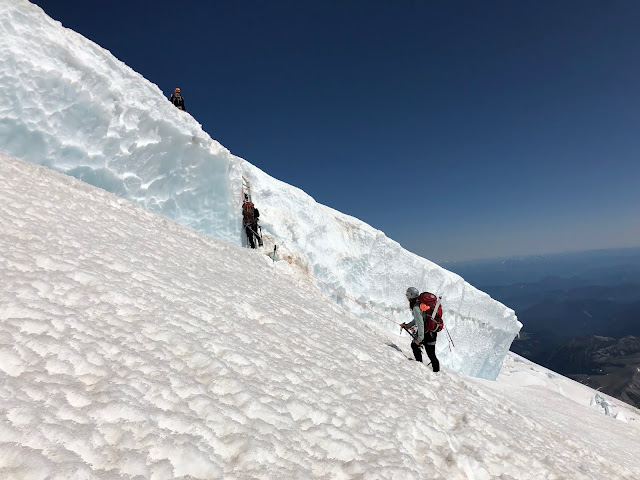 |
| Climber expertly demonstrating 'ready position' with a taut rope on the DC route at 13,000' |
Small ladders and boards are commonly crossed using standard glacier travel technique (just pretend it's a sketchy snow bridge instead of a ladder) and with an emphasis on keeping a taut rope and climbers in the "ready position" to self-arrest. However, as the crevasse crossings get wider, so do the potential free falls a climber is exposed to. Once potential fall gets big enough to question their team's ability to arrest, that team must bolster their fall arrest system.
If taut ropes and a ready, self-arrest position aren't adequate to stop a fall, additional security can be gained by placing and using running protection (running pro) and/or belaying climbers. Both systems don't take much time, but can reduce the chances that a fall will catastrophically pull the whole team into a crevasse. Oftentimes, ladders and boards are held in place with fixed pickets. If a climbing team deems them safe, these pickets are perfectly acceptable to use as anchor points for running pro and belaying.
There is currently one ladder in place on the DC route (pictured above). However, more snow bridges will likely melt away as summer progresses and may be replaced with ladders and boards, if there are no feasible walk-around options. Climbing teams will be rewarded with confidence and time saved by becoming familiar with and practicing these techniques before attempting a climb on Mount Rainier.
Ladders and snow bridges are typically points on the route where back-ups and waits can occur. If you're approaching a 'line' waiting to cross one of these features, try to take a break in a strategic spot and not add to the chaotic scene. Also, try looking for alternative routes - a ladder may be in place just to make the route shorter, but is often times not the only option.
Talk to one of the rangers at high camp if you have any other questions and to get the latest on ladder crossings!
